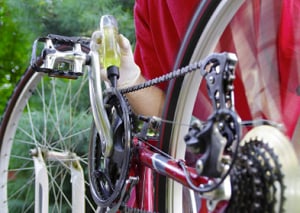As you regularly use your bike to work on errands or leisure, the drive chain can come dry along the process. Applying chain lube on your bike should be prioritized to avert such a situation. Then, how often should you lube your bike chain?
Experts recommend lubing your bike chain every once a month. It is significant to sustain your bike’s optimal performance and protect it from rust and wear over time.
However, considering several factors will help to identify the apt frequency of your bike chain lubrication. Check here to learn more about it.
Table of Contents
When Should You Lube Your Bike Chain?
Subject to the terrain condition and miles covered within the cycle ride, the period of lubricating bicycle chains typically spans from days to a month or upon reaching 100 to 150 miles.
These are the conditions you should reckon with to determine when to lube bike chain:
- After every long ride or tough ride
You should clean the bike chain after every long or difficult bicycle ride. A clean bike chain ensures that your machine can provide an optimized performance without compromising comfort when cycling.
Also, keep in mind to re-apply the grease bike chain following the cleaning procedure.
- After every 100 miles for regular bikes
Some bike types do not require relubrication until reaching the 200 to 500-mile coverage. However, to maintain regular road bikes’ optimal performance, it’d be better to clean and lube a bike chain every 100 miles.
- When the bike is exposed to mud, dirt, and grime
Exposure to mud, dirt, and grime is unavoidable, contingent on the circumstances where you drive in. Likely, this happens with outdoor bike rides, in which accumulation of debris crop up from time to time.
Whenever visible dirt and debris hitch your machine, it is vital to clean and lube a bike chain for guaranteed efficiency in your next bike ride. In this instance, soap is essential to ensure an immaculate chain.
- With dry, wet lube
The lubricant you use is also crucial in deciding when to lube bike chain. These are the bicycle chain lube recommendations you can choose from based on the terrain conditions of your next ride:
A dry lube would be a great option for mountain bikers and some off-road riders cycling on terrains with dry, arid, and moderately wet situations since it won’t attract much dirt.
Yet, wet chain lubricants make the bike chain quieter and smoother, thus providing a better riding experience for a prolonged time.
Dry lubes on bike chains typically last up to 100 miles. On the other hand, wet lubes persist for more than 100 miles, with some brands can reach up to 175 miles without reapplication.
- In summer, winter
Seasonal changes trigger different terrain conditions that predetermine what type of lube should be used accordingly for the bike chain.
The increased temperature, mixed with gravel and dust from dry soil, could penetrate the drivetrain during summertime, making dry lube a better option during the season. Using so, you should apply it every 100 miles or (160 km).
Meanwhile, the relative humidity and freeze-thaw soil that the winter brings make wet lube a fitter choice during the season with its resistance to such conditions.
What is Lube?
Lube is essential to keep the moving parts of your bicycle in its smooth operational state. But how exactly does it help you achieve it?
- Optimal Performance
Keeping your chains intact and healthy is part of procedural maintenance for any bicycle. Correspondingly, regularly lubricating bicycle chains is significant to keep your machine optimally functional.
Doing so requires more than a clean bike chain. Instead, prevent the cause of the damage before contaminating the bike chain and its parts like the internal small pins and rollers, which chain lubricants exactly do.
- Use
Chain lubricants block dust particles and grime buildup by sealing the space between components.
Beyond its foremost purpose of easing the chain’s interaction with the cassette sprockets and chainrings, a bike chain lube could also protect your chains against mechanical wear and tear over time.
While you can use household items such as olive oil on your bike chain, I would only recommend doing so when in a pinch. Likewise, motor oils will not be able to properly protect your chains either, so don’t use these.
- Take Action
As I’ve pointed out, you should always lube your bike chains after every tough ride or when they start to squeak. However, before you take action, pay attention to the kind of lube you choose.
Whether wet or dry, determining the terrain condition is essential to know the frequency of lubrication and how long it would take for the lube to engage in the bike chain.
It will take a few hours to a full overnight for a dry lube to set up before usage. Meanwhile, wet lubes often need less time to integrate.
How to Lube Chain?
You can clean and lube chains in two ways, with regular intact on-bike cleaning and occasional off-bike cleaning.
Regular Intact On-Bike Cleaning
A commuter bike with a road bike chain or ebike chain only requires simple steps to execute spot-cleaning procedures. First, inspect whether your bike chain needs re-lubing.
To do so, stand to one side of your bike and lift the back wheel off the ground. Then, carefully rotate the nearest pedal while checking each chain link for corrosion, dirt accumulation, or tight links.
Begin the spot-cleaning process if you hear squeaks or find the above-stated conditions.
The process for regular on-bike cleaning are:
- Using a degreaser, wash the chain thoroughly. You can use a firm brush or a pair of nail brushes to scrub the links.
- Wash off the degreaser on the bicycle chain with hot water and soap.
- After drying the chains, re-apply a considerable amount of lubricant. You can choose any lube type you want, considering the terrain and weather conditions of your next bike ride.
Occasional Off-Bike Cleaning
In-depth cleaning is beneficial to clean accumulated dirt that on-bike brushing could not remove. This cleaning method is most suitable for vehicles meant for outdoor and rough terrains, like a dirt bike with a motorcycle chain.
You can follow these steps for off-bike chain cleaning:
1) Carefully remove bicycle chains with a chain-removal tool (e.g., master link plier or chain pin tool)
2) Get rid of the accumulated dirt by fully immersing the bike chain with the degreaser. You can use a closed-lid jar and shake it vigorously.
3) Repeat the procedure until the links and bushings are free from debris.
4) Rinse off the degreaser with water and dry it thoroughly.
5) Install the chain back on the bicycle and apply lube as necessary.
Frequently Asked Questions
How do I know if my bike chain needs lube?
Although visual marks and distance covered could help you determine whether or not your bike chain needs lube, the most accurate one would be checking the sounds generated by your internal components.
A knocking, grinding, creaking, and squeaking sound may indicate that your bike chain requires lubrication.
Should I lube my chain after every ride?
Depending on the ride condition and the bike chain lubricant you use, the frequency of lubing you need may vary.
If you use a dry lube while riding on terrains with wet conditions, you may need to re-apply the lubricant before riding again. Similarly, you have to relubricate upon covering the 100-mile range limit of wet lubes.
Overall, it’s important to lube your chain with moderation. Over-lubricating can be just as bad, if not worse – considering how it can wear down the chain at a faster rate.
What happens if you don’t lubricate bike chain?
Bike chain lubrication is significant for efficient ride performance. Therefore, failing to oil bike chain regularly would affect the overall experience that it produces.
The chains will shortly dry up, producing an audible screech. Bicycle shifting will be harder, consequently rust, and may break while on the ride.
A Reddit user, however, mentioned that you should not lubricate new chains because these chains come with a grease-like lubricant designed to penetrate every gap inside the chain.
Are there lube alternatives that I can use for my bike chain?
Besides branded bike chain lubricants, popular household choices for lubrication are olive oil, home greases, and even cooking oil. However, note that these are temporary fixes and should not be deemed long-term solutions.
Some utilize white lithium grease on bike chain lubrication, which experts do not recommend. The solvent has low viscosity and friction that does not suit bike chains. Using one will pick up dirt and may even clog the chain, specifically in between the links.
Conclusion
Bike chain lubrication is maintenance essential that any bike enthusiast should keep in mind. Based on several factors, your bike chain lubrication frequency varies in-between days to a month.
Typically, putting forth the kind of lubricant and terrain conditions you ride could help determine how often should you lube your bike chain.
Remember, putting on adequate bike chain lube will help you have the optimal ride performance you deserve.
We hope that you found the answer you have been looking for here! Consider sharing this article if you found this helpful.
Thank you for reading!

“I ride my bike to work for years, but is that enough? Our carelessness towards our surroundings has taken a toll on the environment. And now, everyone is responsible for changes; even the most minor contribution is counted. With this hope and spirit, I started with my partner to establish Biketoworkday to help more individuals commute to their work sites on their bikes.”







